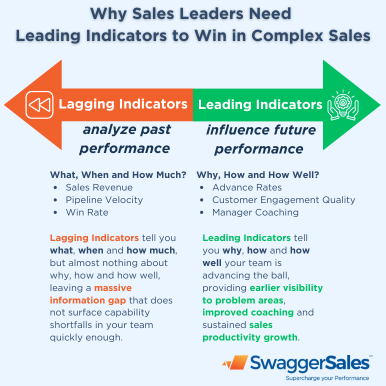Your Guide to Better Sales Leadership Metrics
The leading indicators you need to win more deals in the complex sale
Have you ever found your team coming in second place in a large opportunity or RFP after a year-long pursuit? Toiling away for 12 months, buoyed by optimistic updates from your team, only to finish in the worst possible position – second, with nothing but the ache of unrewarded effort? Have you ever done a de-brief on a lost deal and realized afterwards that the rep leading the sale didn’t really have the capabilities needed to win? (and the front-line manager didn’t spot it?) In this article, we’ll explain how you can start using some simple, forward-looking data that will help you spot problem areas early, and course correct before it’s too late.
What’s missing from the most common pipeline metrics?
Most sales leaders track their business with pipeline KPIs like quarterly sales revenue, pipeline velocity, win rates, and renewal rates (customer retention) to measure success. These are all, obviously, critical in assessing and managing performance.
But they have two significant limitations:
- They are all lagging indicators. A pipeline is, by its nature, a measure of what has already happened in the sale – its predictive value is limited.
- They tell you what, when and how much, but as a sales leader, they tell you almost nothing about “why,” “how,” and “how well.” It’s hard to get better or more productive without that information.
Fast vs. slow feedback loops
In high velocity sales where the sales cycle is short and the feedback loop (“effort to outcome”) is fast, these pipeline metrics may be all you need for performance management. After all, with a 6-week sales cycle, a salesperson’s win rates over a quarter will be a pretty good proxy for capabilities. But they fall short in complex sales processes that might last 3, 6, 12 months (or for enterprise, even a couple of years), leading to painful surprises at the end of sales cycles.
Why complex sales require a different breed of KPIs
Complex sales not only involve longer sales cycles and larger deal sizes, but they advance in a highly non-linear fashion. These sales tend to move slowly most of the time, and very fast occasionally.
I’ve seen $50MM deals that took 100 sales meetings to get across the finish line, but of all those meetings, there were perhaps only seven or eight that were critical in determining whether the deal would be won or lost. In a complex sales environment, a single great meeting can propel the sale forward by leaps and bounds; conversely, a single bad one can kill the entire deal.
That’s why “activity metrics” (like how many meetings per month a rep takes) are such a bad idea. I was talking with the VP of Sales at a large European diagnostics company recently who kept a leaderboard of “activity per rep”. Of his top three most active salespeople, one was a rain-maker – a regular President’s Prize winner – The other two were being performance-managed out of the business.
In other words, sales activity bears little relation to performance.
In complex sales, your best salespeople aren’t necessarily working harder; instead, they know how to execute the big meetings well. If you’ve ever watched champion soccer player Lionel Messi play, you’ll see a lot of slow walking, with occasional explosive moves that win the game.
Read about how you can create more Messi’s on your sales team!
Let’s look at a couple of simple measures that will help you spot problems early and decode and replicate the “secret sauce” of your top performers.
Leading Indicator #1: Advance Rate
Win rates on long sales cycle deals are clearly severely lagging indicators. But the ability of a sales rep or sales team to execute the big sales meeting and gain the “advance” they planned from the meeting, (for example an intro to the right executives, or C-Suite conceptual agreement to create a budget, or agreement to run a trial) is one of the biggest indicators of a sales rep’s capability. This insight shifts focus from quantity to quality of customer engagements.
The endgame of a meeting isn’t to check a box; it’s to achieve specific, tangible goals (the “advance”). A well-executed advance, with a meeting goal documented in advance of the meeting, speaks volumes about a rep’s capabilities, far more than any post-meeting call log ever could.
Leading Indicator #2: Client Conversation Quality: Getting Beyond the Product
We see three broad types of value proposition discussions that salespeople engage in with customers and prospects:
- Product and service (technical),
- Financial and operational (organizational), and
- The “care-abouts” of individual stakeholders (personal).
Your skilled salespeople are adept at getting a dialog about the client’s business, not your product. They know that finding and addressing a client’s pain and solving (and monetizing) big organizational problems is more impactful than any shiny feature/benefit.
But only your very best salespeople will tend to be able to build the credibility and trust necessary to uncover personal wins/losses and pain points of the key decision makers. But it’s these pain points that really move the needle. And it’s the skills of these salespeople that you want to replicate across your mid-performing sales reps to drive higher productivity.
Your front-line managers should be monitoring the focus of their team’s conversations in critical sales meetings and coaching the competency gaps in their team. And your role as a leader is to hold these managers accountable for that (not just for hitting this quarter’s numbers).
Ensure your front-line managers can coach people, not just deals.

Simple tools to see leading indicators and spot problems early
While “quality of key customer meetings” doesn’t roll up easily into a simple numeric dashboard, it’s quite simple to provide tools that can give you this ability to spot problems early:
- Implementing a simple, robust pre-call planning process for important customer meetings not only lifts the productivity of your salespeople but feeds a coaching engine for your front-line managers. Pre-call plans are brilliant at surfacing gaps in a rep’s mindset, optimism and competencies.
- If this call planning is integrated into your CRM, the drill-down visibility you will have as a sales leader – not just to call plans and meeting “advances” but to the Manager coaching that should go alongside them – drives a level of discipline and accountability in the field that is just not possible with paper-based tools. (Have you explored CRM-native apps that do all of this?) Learn more about Swagger SWIFTTM App for Salesforce
While immediate quarterly results will (and should) always demand your attention as a sales leader, allocating at least 15% of your efforts towards these leading indicators can deliver transformative results in complex sales environments.
Pipeline will determine this quarter’s results, but the call plans for big meetings, the advance rates of your reps and the manager coaching that goes alongside them will drive next quarter’s results, and the quarter after next, and the one after that.
Sales Training Trusted by Some of the Biggest Medical Device Companies!
Want sales training that’s guaranteed to pay for itself within three months? You’re in the right place…
- Brilliantly simple and effective skills to move beyond price, navigate higher in your client organizations and sell on value
- Modular curriculum – fully customized to your business, your deals and your market
- Available in-person or remote, anywhere in the world, and licensable for internal delivery
